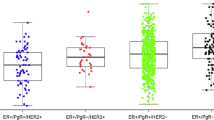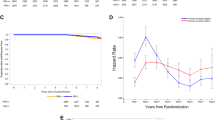Abstract
Objectives
Tamoxifen is a partial ER antagonist that is highly effective in the treatment of receptor positive breast cancer. It significantly reduces recurrence and improves survival in both pre- and postmenopausal women. Unfortunately, many ER+ positive tumors progress despite tamoxifen treatment and until now, no possibility exists to prospectively identify tamoxifen-resistant tumors. It has been suggested that that in HER2 over-expressing tumors, cross-talk via activated HER2 receptors is a key mechanisms by which tumors become tamoxifen-resistant.
Methods
We have therefore used immunohistochemistry to analyze the expression of HER2 and activated ptyr-1248 HER2 in 408 women of ER+, early breast cancer who had received at least 2 years of adjuvant tamoxifen. We then analyzed possible associations between HER2 and pHER2 expression, and prognostic parameters, and evaluated the effect of HER2 expression and survival.
Results
With HER2 being positive in 12 of 208 (2.9%) of ER+ positive tumors, HER2 overexpression was found to be considerably less common in ER+ tumors than what has been thought previously. The majority of HER2 overexpressing tumors, however, also expressed the activated receptor form (r = 0.664; P < 0.0001). Both HER2 and pHER2 are moderately correlated with Grading (r = 0.138; P = 0.0052 and r = 0.118; P = 0.0241, respectively) and nodal involvement (r = 0.163; P = 0.0018 and r = 0.134; P = 0.016, respectively), but neither HER2 nor its activated form are significant predictors of RFS, DFS, or OS.
Conclusions
Taken together, we have demonstrated that in ER+ breast cancer, the HER2 receptor is commonly activated, but its low prevalence in ER+ tumors does not render it a useful prognostic parameter in tamoxifen-treated patients.

Similar content being viewed by others
References
Bilous M, Ades C, Armes J, Bishop J, Brown R, Cooke B, Cummings M, Farshid G, Field A, Morey A, McKenzie P, Raymond W, Robbins P, Tan L (2003) Predicting the HER2 status of breast cancer from basic histopathology data: an analysis of 1,500 breast cancers as part of the HER2000 international study. Breast 12(2):92–98. doi:10.1016/S0960-9776(02)00273-4
Birner P, Oberhuber G, Stani J, Reithofer C, Samonigg H, Hausmaninger H, Kubista E, Kwasny W, Kandioler-Eckersberger D, Gnant M, Jakesz R (2001) Austrian breast and colorectal cancer study group. Evaluation of the United States food and drug administration-approved scoring and test system of HER-2 protein expression in breast cancer. Clin Cancer Res 7(6):1669–1675
Biswas DK, Cruz AP, Gansberger E, Pardee AB (2000) Epidermal growth factor-induced nuclear factor kappa B activation: a major pathway of cell-cycle progression in estrogen-receptor negative breast cancer cells. Proc Natl Acad Sci USA 97:8542–8547. doi:10.1073/pnas.97.15.8542
Ciocca D, Fujimura F, Tandon A, Clark G, Mark C, Lee-Chen G, Pounds G, Vendely P, Owens M, Pandian M (1992) Correlation ofHER-2/neu amplificationwith expression and with other prognostic factors in 1,103 breast cancers. J Natl Cancer Inst 84:1279–1282. doi:10.1093/jnci/84.16.1279
Early Breast Cancer Trialists’ Collaborative Group (1998) Tamoxifen for early breast cancer: an overview of the randomised trials. Lancet 351(9114):1451–1467. doi:10.1016/S0140-6736(97)11423-4
Ellis MJ, Coop A, Singh B, Mauriac L, Llombert-Cussac A, Jänicke F, Miller WR, Evans DB, Dugan M, Brady C, Quebe-Fehling E, Borgs M (2001) Letrozole is more effective neoadjuvant endocrine therapy than tamoxifen for ErbB-1- and/or ErbB-2-positive, estrogen receptor-positive primary breast cancer: evidence from a phase III randomized trial. J Clin Oncol 19(18):3808–3816
Gee JM, Robertson JF, Gutteridge E, Ellis IO, Pinder SE, Rubini M, Nicholson RI (2005) Epidermal growth factor receptor/HER2/insulin-like growth factor receptor signalling and oestrogen receptor activity in clinical breast cancer. Endocr Relat Cancer 12(Suppl 1):S99–S111. doi:10.1677/erc.1.01005
Holloway JN, Murthy S, El-Ashry D (2004) A cytoplasmic substrate of mitogen-activated protein kinase is responsible for estrogen receptor-alpha down-regulation in breast cancer cells: the role of nuclear factor-kappa B. Mol Endocrinol 18:1396–1410. doi:10.1210/me.2004-0048
Huang HJ, Neven P, Drijkoningen M, Paridaens R, Wildiers H, Van Limbergen E, Berteloot P, Amant F, Vergote I, Christiaens MR (2005) Hormone receptors do not predict the HER2/neu status in all age groups of women with an operable breast cancer. Ann Oncol 16(11):1755–1761. doi:10.1093/annonc/mdi364
Konecny G, Pauletti G, Pegram M, Untch M, Dandekar S, Aguilar Z, Wilson C, Rong HM, Bauerfeind I, Felber M et al (2003) Quantitative association between HER-2/neu and steroid hormone receptors in hormone receptor-positive primary breast cancer. J Natl Cancer Inst 95:142–153
Massarweh S, Osborne CK, Shou J, Wakeling AE, Rimawi M, Mohsin SK, Hilsenbeck S, Schiff R (2006) Mechanisms of tumour regression and resistance to estrogen deprivation and fulvestrant in a model of estrogen receptor-positive, Her-2 breast cancer. Cancer Res 66:8266–8273. doi:10.1158/0008-5472.CAN-05-4045
Massarweh S, Osborne CK, Creighton CJ, Qin L, Tsimelzon A, Huang S, Weiss H, Rimawi M, Schiff R (2008) Tamoxifen resistance in breast tumors is driven by growth factor receptor signaling with repression of classic estrogen receptor genomic function. Cancer Res 68(3):826–833. doi:10.1158/0008-5472.CAN-07-2707
Ménard S, Fortis S, Castiglioni F, Agresti R, Balsari A (2001) HER2 as a prognostic factor in breast cancer. Oncology 61(Suppl 2):67–72. doi:10.1159/000055404
Osborne CK, Shou J, Massarweh S, Schiff R (2005) Crosstalk between estrogen receptor and growth factor receptor pathways as a cause for endocrine therapy resistance in breast cancer. Clin Cancer Res 11(2 Pt 2):865s–870s
Owens MA, Horten BC, Da Silva MM (2004) HER2 amplification ratios by fluorescence in situ hybridization and correlation with immunohistochemistry in a cohort of 6,556 breast cancer tissues. Clin Breast Cancer 5:63–69. doi:10.3816/CBC.2004.n.011
Reiner A, Neumeister B, Spona J, Reiner G, Schemper M, Jakesz R (1990) Immunocytochemical localization of estrogen and progesterone receptor and prognosis in human primary breast cancer. Cancer Res 50(21):7057–7061
Schiff R, Massarweh SA, Shou J, Bharwani L, Arpino G, Rimawi M, Osborne CK (2005) Advanced concepts in estrogen receptor biology and breast cancer endocrine resistance: implicated role of growth factor signaling and estrogen receptor coregulators. Cancer Chemother Pharmacol 56(Suppl 1):10–20. doi:10.1007/s00280-005-0108-2
Shou J, Massarweh S, Osborne CK, Wakeling AE, Ali S, Weiss H, Schiff R (2004) Mechanisms of tamoxifen resistance: increased estrogen receptor-HER2/neu cross-talk in ER/HER2-positive breast cancer. J Natl Cancer Inst 96(12):926–935
Singer CF, Köstler WJ, Hudelist G (2008) Predicting the efficacy of trastuzumab-based therapy in breast cancer: current standards and future strategies. Biochim Biophys Acta [epub ahead of print]
Slamon DJ, Clark GM, Wong SG et al (1987) Human breast cancer: correlation of relapse and survival with amplification of the HER-2/neu oncogene. Science 235:177–182. doi:10.1126/science.3798106
Slamon DJ, Godolphin W, Jones LA et al (1989) Studies of the HER-2/neu proto-oncogene in human breast and ovarian cancer. Science 244:707–712. doi:10.1126/science.2470152
Stoica A, Saceda M, Fakhro A, Joyner M, Martin MB (2000) Role of insulin-like growth factor-I in regulating estrogen receptor-alpha gene expression. J Cell Biochem 76:605–614. doi:10.1002/(SICI)1097-4644(20000315)76:4<605::AID-JCB9>3.0.CO;2-T
Tang C, Perez C, Grunt T, Waibel C, Cho C, Lupu R (1996) Involvement of heregulin-beta2 in the acquisition of the hormone-independent phenotype of breast cancer cells. Cancer Res 56:3350–3358
Taucher S, Rudas M, Mader RM, Gnant M, Dubsky P, Roka S, Bachleitner T, Kandioler D, Steger G, Mittlböck M, Jakesz R (2004) Prognostic markers in breast cancer: the reliability of HER2/neu status in core needle biopsy of 325 patients with primary breast cancer. Wien Klin Wochenschr 116(1–2):26–31
Yaziji H, Goldstein LC, Barry TS et al (2004) HER-2 testing in breast cancer using parallel tissue-based methods. JAMA 291:1972–1977. doi:10.1001/jama.291.16.1972
Zeillinger R, Kury F, Czerwenka K, Kubista E, Sliutz G, Knogler W, Huber J, Zielinski C, Reiner G, Jakesz R et al (1989) HER-2 amplification, steroid receptors and epidermal growth factor receptor in primary breast cancer. Oncogene 4:109–114
Conflict of interest statement
None.
Author information
Authors and Affiliations
Corresponding author
Rights and permissions
About this article
Cite this article
Singer, C.F., Gschwantler-Kaulich, D., Fink-Retter, A. et al. HER2 overexpression and activation, and tamoxifen efficacy in receptor-positive early breast cancer. J Cancer Res Clin Oncol 135, 807–813 (2009). https://doi.org/10.1007/s00432-008-0516-x
Received:
Accepted:
Published:
Issue Date:
DOI: https://doi.org/10.1007/s00432-008-0516-x




